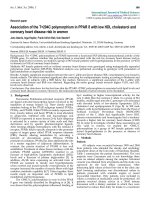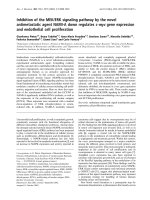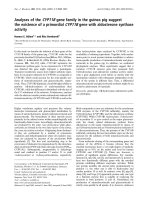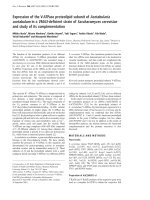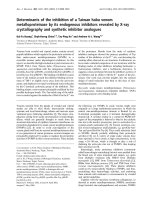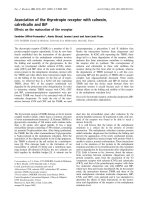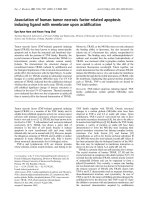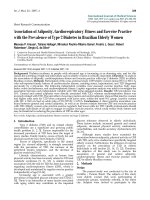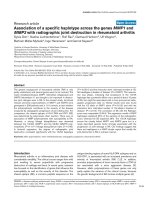Báo cáo y học: "Association of a single nucleotide polymorphism in growth differentiate factor 5 with congenital dysplasia of the hip: a case-control study" ppt
Bạn đang xem bản rút gọn của tài liệu. Xem và tải ngay bản đầy đủ của tài liệu tại đây (124.49 KB, 5 trang )
Open Access
Available online />Page 1 of 5
(page number not for citation purposes)
Vol 10 No 5
Research article
Association of a single nucleotide polymorphism in growth
differentiate factor 5 with congenital dysplasia of the hip: a
case-control study
Jin Dai
1,2
*, Dongquan Shi
1,2
*, Pengsheng Zhu
3
, Jianghui Qin
1
, Haijian Ni
1
, Yong Xu
1
, Chen Yao
1
,
Lunqing Zhu
3
, Hongtao Zhu
3
, Baocheng Zhao
3
, Jia Wei
4
, Baorui Liu
4
, Shiro Ikegawa
5
,
Qing Jiang
1,2
and Yitao Ding
6
1
The Center of Diagnosis and Treatment for Joint Disease, Drum Tower Hospital Affiliated to Medical School of Nanjing University, Nanjing 210008,
Jiangsu, PR China
2
Laboratory for Bone and Joint Diseases, Model Animal Research Center, Nanjing University, Nanjing 210008, Jiangsu, PR China
3
Center of Diagnosis and Treatment for Congenital dysplasia of hip, Kang'ai Hospital, Nanjing 210008, Jiangsu, PR China
4
Department of Oncology, Drum Tower Hospital Affiliated to Medical School of Nanjing University, Nanjing 210008, Jiangsu, PR China
5
Laboratory for Bone and Joint Diseases, SNP Research Center, RIKEN, Tokyo 108-8639, Japan
6
Department of Hepatobiliary Surgery, Drum Tower Hospital Affiliated to Medical School of Nanjing University, Nanjing 210008, Jiangsu, PR China
* Contributed equally
Corresponding author: Qing Jiang, & Yitao Ding,
Received: 21 Aug 2008 Revisions requested: 16 Sep 2008 Revisions received: 9 Oct 2008 Accepted: 24 Oct 2008 Published: 24 Oct 2008
Arthritis Research & Therapy 2008, 10:R126 (doi:10.1186/ar2540)
This article is online at: />© 2008 Dai et al.; licensee BioMed Central Ltd.
This is an open access article distributed under the terms of the Creative Commons Attribution License ( />),
which permits unrestricted use, distribution, and reproduction in any medium, provided the original work is properly cited.
Abstract
Introduction Congenital dysplasia of the hip is an abnormal
seating of the femoral head in the acetabulum, mainly caused by
shallow acetabulum and lax joint capsule. Genetic factors play a
considerable role in the pathogenesis of congenital dysplasia of
the hip. The gene growth differentiate factor 5 (GDF5) has been
implicated in skeletal development and joint morphogenesis in
humans and mice. A functional single nucleotide polymorphism
(SNP) in the 5'-untranslated region of GDF5 (rs143383) was
reported to be associated with osteoarthritis susceptibility. As a
key regulator in morphogenesis of skeletal components and soft
tissues in and around the joints, GDF5 may be involved in the
aetiology and pathogenesis of congenital dysplasia of the hip.
Our objective is to evaluate if the GDF5 SNP is associated with
congenital dysplasia of the hip in people of Han Chinese origin.
Methods The GDF5 SNP was genotyped in 338 children with
congenital dysplasia of the hip and 622 control subjects.
Results The SNP was significantly associated with congenital
dysplasia of the hip (p = 0.0037; odds ration (OR) = 1.40; 95%
confidence interval (CI) = 1.11 to 1.75). A significant difference
was detected in female samples when stratified by gender (p =
0.0053; OR = 1.46; 95% CI = 1.21 to 1.91), and in hip
dislocation when stratified by severity (p = 0.0078; OR = 1.43;
95% CI = 1.11 to 1.85).
Conclusions Our results indicate that GDF5 is important in the
aetiology of congenital dysplasia of the hip. To the authors'
knowledge this is the first time that a definite association with
the congenital dysplasia of the hip susceptibility has been
detected.
Introduction
Congenital dysplasia of the hip (CDH; MIM 142700) is one of
the most common congenital skeletal anomalies. CDH is an
abnormal seating of the femoral head in the acetabulum [1].
CDH acts as a significant risk factor for the development of hip
osteoarthritis [2-4]. Shallow acetabulum and lax capsule
around the hip joint are the main causes of CDH [5,6]. Former
epidemiological investigations show that CDH has a consider-
able genetic component. Several family studies of CDH have
showed that its prevalence was significantly higher in first-
degree relatives of probands [7-9]. A study of identical twins
indicated hereditary factors are of prime importance in CDH
[10], and a genome-wide screening of a Japanese family with
acetabular dysplasia identified a linkage on a limited location
of the specific chromosome [11].
CDH: congenital dysplasia of the hip; CI: confidence interval; GDF5: growth differentiate factor 5; OR: odds ratio; SNP: single nucleotide polymor-
phism; TGF-β: transforming growth factor-β.
Arthritis Research & Therapy Vol 10 No 5 Dai et al.
Page 2 of 5
(page number not for citation purposes)
Growth differentiate factor 5 (GDF5; also known as cartilage-
derived morphogenetic protein-1) is a member of the trans-
forming growth factor-β (TGF-β) super-family. GDF5 is
expressed in the regions between skeletal elements where
joints will later form [12,13]. It plays a crucial role in the mor-
phogenesis of tendon, ligament and bone. A null mutation of
GDF5 causes developmental failure of skeletal structure and
intra-articular ligaments in mice [14,15]. Type C brachydactyly
(MIM 113100) is a skeletal disorder caused by GDF5 muta-
tion [16,17], and some patients with type C brachydactyly also
present with dysplasia of hip joints [18,19].
Recently, a functional single nucleotide polymorphism (SNP)
in the 5'-untranslated region of GDF5 (rs143383; +104T/C)
was found to be significantly associated with osteoarthritis in
people of Japanese and Han Chinese origin [20]. This SNP
was located in the GDF5 core promoter and exerted allelic dif-
ferences in promoter activity of the GDF5 gene. The suscepti-
bility allele (+104T) showed reduced transcriptional activity of
GDF5 in chondrogenic cells [20]. Association of this SNP
with osteoarthritis has been replicated in people of European
origin [21]. These findings suggest that GDF5, especially the
functional SNP rs143383, may play a key role in the aetiology
and pathogenesis of CDH. To evaluate this possible associa-
tion, we examined the genetic association of the GDF5 SNP
with CDH in people of Han Chinese origin and found a com-
pelling association between GDF5 and CDH.
Materials and methods
Subjects
A total of 960 subjects were enrolled in this study. Three hun-
dred and thirty-eight patients (291 females and 47 males)
were enrolled consecutively at the Center of Diagnosis and
Treatment for Congenital dysplasia of hip, Kang'ai Hospital,
China; 622 healthy control subjects (316 females and 306
males) were enrolled at the Physical Examination Center,
Drum Tower Hospital, affiliated to the Medical School of Nan-
jing University, China. The controls had no symptoms or histo-
ries of CDH. All subjects included in the study were of Han
Chinese origin living in and around Nanjing. No subjects
dropped out during the process of the study. The study was
approved by the ethical committee of the participating institu-
tions, and informed consent was obtained from patients and
controls.
Patients were diagnosed by expert medical examination with
radiographic evidence, and they all had unilateral or bilateral
CDH. Cases with systemic syndrome were excluded from the
study. Control subjects were identified by taking a detailed his-
tory and physical examination. The severity of CDH was
defined from mild instability of the femoral head with slight
capsular laxity, to moderate lateral displacement of the femoral
head, without loss of contact of the head with the acetabulum,
and then to complete dislocation of the femoral head from the
acetabulum [22]. Cases were scored according to the severity
of the hip disorder (1 = instability; 2 = subluxation; 3 = dislo-
cation).
Genotyping
DNA was obtained from all the subjects from peripheral blood
using the Chelex-100 method [23] or buccal swabs using the
DNA IQ System (Promega, Madison, WI) according to the
manufacturer's instructions. The SNP rs143383 was geno-
typed using Taqman assay (Applied Biosystems 7500, ABI,
Foster City, CA,. USA). Genotyping was performed by labora-
tory personnel blinded to case status, and two authors inde-
pendently reviewed the genotyping results, data entry and
statistical analyses.
Statistics
A chi-squared test was used to compare the GDF5 genotype
with the allele distributions in the case-control study. The dif-
ferences in the clinical information between the genotypes
were tested using the Mann-Whitney test, the Kruskal-Wallis
test and the chi-squared test. The linear trend of severity was
analysed by chi-squared test. Hardy-Weinberg equilibrium
was performed by chi-squared test. These tests were per-
formed using SPSS 12.0 system software (SPSS Inc., Chi-
cago, Illinois, USA).
Results
The ages of patients with CDH and controls (mean ± SD)
were 21.6 ± 12.4 months (range 2 to 72 months) and 58.1 ±
11.0 years (range, 39 to 94 years), respectively. More than
50% of the CDH cases were delivered by caesarean section.
The ratio of female to male was about six to one in patients with
CDH. Distributions of genotypes in the CDH and control
groups were conformed to Hardy-Weinberg equilibrium (p =
0.77 and 0.50, respectively) (Table 1). The distribution of the
severity of the hip disease was 6% with score 1, 16% with
score 2 and 78% with score 3 (Table 2). Significant differ-
ences in allele frequency was detected between CDH and
control groups (p = 0.0037) (Table 3). Significant differences
in the genotype frequency were observed in the comparison of
TT (T allele homozygote) and other genotypes combined (p =
0.013), and in a comparison of CC (C allele homozygote) and
other genotypes combined (p = 0.029) (Table 3). No signifi-
cant difference was found between different delivery methods
(p = 0.78).
We stratified subjects by gender and compared the genotype
distribution and allele frequency. In female samples, the most
significant difference was observed in the allele frequency (p
= 0.0053) (Table 3). The genotype distribution and allele fre-
quency in male members of the CDH and control groups were
similar to that in the female samples and all samples as a
whole. No significant difference was detected in the compari-
son of genotype and allele frequency between male CDH and
control subjects (Table 3). No significant difference was
detected in any comparisons between female and male cases
Available online />Page 3 of 5
(page number not for citation purposes)
or female and male controls. A significant difference was found
between samples with hip dislocation when stratified by sever-
ity (p = 0.0078) and no significant difference was found in
subjects with hip instability and subluxation (Table 4). When all
subjects were stratified by severity (0 = control; 1 = instability;
2 = subluxation; 3 = dislocation), a significant increasing linear
trend (p = 0.020) was seen in the T allele frequency as the
severity worsened.
Discussion
To the authors' knowledge this is the first demonstration of a
compelling association betweenn functional GDF5 SNP
rs143383 and CDH in the Han Chinese population. Signifi-
cant differences were observed in allele frequency, and in
comparisons of TT versus other genotypes combined and CC
versus other genotypes combined. Significant differences
were also observed in females after stratification of gender.
Distribution of genotype in males was similar to that in females
and the group as a whole, although no significant differences
were detected in genotype and allele frequencies. No signifi-
cant difference was found in any comparison between female
and male subjects. The lack of significance in male subjects
may be due to the limited sample number, although a large sex
bias of CDH incidence obviously exists. To clarify this possible
association, further research should be conducted with a
larger sample number.
We discovered the significant association with hip dislocation
when stratified by severity, but not with subluxation and insta-
bility. A significant increasing linear trend in the T allele fre-
quency as the severity worsens was also observed. This
indicates that the SNP may be associated with severity of
CDH, but a definite conclusion could not be made because
the sample number was so limited and no significant associa-
tion was detected among groups of different severity.
GDF5 has been found to play an indispensable role in joint
morphogenesis and GDF5 can promote the condensation of
mesenchymal cells, which is the initiate step of developing car-
tilage element. GDF5 can also enhance chondrogenic differ-
entiation of mesenchymal cells [24-28]. The T allele of
rs143383 was overrepresented in CDH, and it showed a
reduced transcriptional activity of GDF5 in vitro and in vivo
[20,21]. Reduced expression of GDF5 would decrease the
Table 1
Genotype and allele frequencies of C/T transition SNP (rs143383) of the GDF5 gene in the Han Chinese population.
Group Number of subject Genotype (frequency) Allele (frequency) Hardy-Weinberg equilibrium
TT TC CC T C P value
CDH
All 338 214 (0.633) 111 (0.328) 13 (0.039) 539 (0.797) 137 (0.203) 0.77
Female 291 185 (0.636) 95 (0.326) 11 (0.038) 465 (0.799) 117 (0.201) 0.78
Male 47 29 (0.617) 16 (0.340) 2 (0.043) 74 (0.787) 20 (0.213) 0.91
Control
All 622 342 (0.550) 234 (0.376) 46 (0.074) 918 (0.738) 326 (0.262) 0.50
Female 316 169 (0.535) 124 (0.392) 23 (0.073) 462 (0.731) 170 (0.269) 0.97
Male 306 173 (0.565) 110 (0.360) 23 (0.075) 456 (0.745) 156 (0.255) 0.35
CDH = congenital dysplasia of the hip; GDF5 = growth differentiate factor 5; SNP = single nucleotide polymorphism.
Table 2
Genotype and allele frequencies of C/T transition SNP (rs143383) of the GDF5 gene in different CDH categories when stratified by
severity
Group Number of subjects (%) Genotype (frequency) Allele (frequency) Hardy-Weinberg equilibrium
TT TC CC T C P value
CDH
Instability 21 (6%) 14 (0.667) 6 (0.286) 1 (0.047) 34 (0.810) 8 (0.190) 0.74
subluxation 53 (16%) 33 (0.622) 18 (0.340) 2 (0.038) 84(0.792) 22(0.208) 0.81
Dislocation 264 (78%) 167 (0.633) 87 (0.329) 10 (0.038) 421 (0.797) 107 (0.203) 0.75
CDH = congenital dysplasia of the hip; GDF5 = growth differentiate factor 5; SNP = single nucleotide polymorphism.
Arthritis Research & Therapy Vol 10 No 5 Dai et al.
Page 4 of 5
(page number not for citation purposes)
condensation and chondrogenic differentiation of mesenchy-
mal cells and result in a reduction in the amount of chondro-
genic cells in hip joints. It leads to a developmental deficiency
of the acetabulum and proximal femoral element, especially the
femoral head. As mentioned above, the absence of GDF5 can
cause developmental failure of intra-articular ligaments in mice
[14], so we suspected that a reduction of GDF5 expression
may also lead to developmental deficiency of the ligaments
and capsule in and around the human hip joint. Insufficiency of
osteal elements and soft tissues in and around hip joints could
contribute to susceptibility to CDH simultaneously or individu-
ally. Further study on local expression of GDF5 is needed to
explore detailed mechanisms between reduced GDF5 expres-
sion and CDH.
Several association studies have been carried out to detect
the susceptibility gene for CDH [29-33], and most of them
produced negative results [29-31]. One study found that a
MSX1 polymorphism was associated with limb deficiency
defects including CDH [32], but it no individual data for CDH
was shown. Two polymorphisms in type II collagen and vitamin
D receptor genes were reported to be associated with oste-
oarthritis secondary to hip dysplasia [33], but another study
showed a negative association of these two polymorphisms
with nonsyndromic CDH [29]. Whether these two polymor-
phisms are associated with hip dysplasia or with osteoarthritis
is still disputed. Our study is the first report of association
between SNP and clearly defined CDH. Further studies
should be conducted with larger sample numbers in different
ethnic groups.
Conclusions
Our study suggested that there is an association between
GDF5 and CDH susceptibility in a Chinese Han population.
Competing interests
The authors declare that they have no competing interests.
Authors' contributions
All authors contributed to the final manuscript. In addition, JD
and DQS genotyped the samples and participated in the
design and analysis of the study. PZ, JQ, HN, YX, CY, LZ, HZ,
BZ and JW evaluated the patients and genotyped these sam-
ples. BL and SI coordinated the study. QJ and YD supervised
the whole study.
Table 3
Association of C/T polymorphism of the GDF5 gene with CDH when stratified by gender
Groups compared TT vs. other combined CC vs. other combined T allele vs. C allele All genotype
OR P value 95% CI OR P value 95% CI OR P value 95% CI P value
All patients (n = 338) vs all
controls (n = 622)
1.41 0.013 1.08 to 1.85 0.50 0.029 0.27 to 0.94 1.40 0.0037 1.11 to 1.75 0.014
Female patients (n = 291) vs
female controls (n = 316)
1.52 0.012 1.10 to 2.10 0.50 0.061 0.24 to 1.05 1.46 0.0053 1.21 to 1.91 0.020
Male patients (n = 47) vs male
controls (n = 306)
1.24 0.51 0.66 to 2.33 0.55 0.42 0.12 to 2.40 1.27 0.38 0.75 to 2.14 0.65
CDH = congenital dysplasia of the hip; CI = confidence interval; GDF5 = growth differentiate factor 5; OR = odds ratio.
Table 4
Association of C/T polymorphism of the GDF5 gene with CDH when stratified by severity
Groups compared TT vs. other combined CC vs. other combined T allele vs. C allele All genotype
OR P value 95% CI OR P value 95% CI OR P value 95% CI P value
Patients with hip dislocation (n =
264) vs all controls (n = 622)
1.41 0.023 1.05 to 1.89 0.49 0.044 0.24 to 0.99 1.40 0.0078 1.09 to 1.79 0.028
Patients with hip subluxation (n =
53) vs all controls (n = 622)
1.35 0.31 0.76 to 2.41 0.49 0.32 0.12 to 2.08 1.36 0.22 0.83 to 2.20 0.46
Patients with hip instability (n = 21)
vs all controls (n = 622)
1.64 0.29 0.65 to 4.11 0.63 0.65 0.08 to 4.77 1.51 0.30 0.69 to 3.29 0.57
CDH = congenital dysplasia of the hip; CI = confidence interval; GDF5 = growth differentiate factor 5; OR = odds ratio.
Available online />Page 5 of 5
(page number not for citation purposes)
Acknowledgements
This work was supported by the National Nature Science Foundation of
China (30571874) (to DS and QJ) and Programme of Technology
Development of Nanjing (200603001) (to DS and QJ).
References
1. Sollazzo V, Bertolani G, Calzolari E, Atti G, Scapoli C: A two-locus
model for non-syndromic congenital dysplasia of the hip
(CDH). Ann Hum Genet 2000, 64:51-59.
2. Jacobsen S, Sonne-Holm S: Hip dysplasia: a significant risk fac-
tor for the development of hip osteoarthritis. A cross-sectional
survey. Rheumatology (Oxford) 2005, 44:211-218.
3. Lane NE, Lin P, Christiansen L, Gore LR, Williams EN, Hochberg
MC, Nevitt MC: Association of mild acetabular dysplasia with
an increased risk of incident hip osteoarthritis in elderly white
women: the study of osteoporotic fractures. Arthritis Rheum
2000, 43:400-404.
4. Reijman M, Hazes JM, Pols HA, Koes BW, Bierma-Zeinstra SM:
Acetabular dysplasia predicts incident osteoarthritis of the
hip: the Rotterdam study. Arthritis Rheum 2005, 52:787-793.
5. Wilkinson J, Carter C: Congenital dislocation of the hip: the
results of conservative treatment. J Bone Joint Surg Br 1960,
42:669-688.
6. Carter C, Wilkinson J: Persistent joint laxity and congenital dis-
location of the hip. J Bone Joint Surg Br 1964, 46:40-45.
7. Woolf CM, Koehn JH, Coleman SS: Congenital hip disease in
Utah: the influence of genetic and nongenetic factors. Am J
Hum Genet 1968, 20:430-439.
8. Kramer AA, Berg K, Nance WE: Familial aggregation of congen-
ital dislocation of the hip in a Norwegian population. J Clin Epi-
demiol 1988, 41:91-96.
9. Czeizel A, Szentpetery J, Tusnady G, Vizkelety T: Two family stud-
ies on congenital dislocation of the hip after early orthopaedic
screening Hungary. J Med Genet 1975, 12:125-130.
10. Geiser M, Buri B, Buri P: Congenital dislocation of the hip in
identical twins. J Bone Joint Surg Br 1959, 41:314-318.
11. Mabuchi A, Nakamura S, Takatori Y, Ikegawa S: Familial osteoar-
thritis of the hip joint associated with acetabular dysplasia
maps to chromosome 13q. Am J Hum Genet 2006,
79:163-168.
12. Storm EE, Kingsley DM: Joint patterning defects caused by sin-
gle and double mutations in members of the bone morphoge-
netic protein (BMP) family.
Development 1996,
122:3969-3979.
13. Thomas JT, Lin K, Nandedkar M, Camargo M, Cervenka J, Luyten
FP: A human chondrodysplasia due to a mutation in a TGF-
beta superfamily member. Nat Genet 1996, 12:315-317.
14. Harada M, Takahara M, Zhe P, Otsuji M, Iuchi Y, Takagi M, Ogino
T: Developmental failure of the intra-articular ligaments in
mice with absence of growth differentiation factor 5. Osteoar-
thritis Cartilage 2007, 15:468-474.
15. Masuya H, Nishida K, Furuichi T, Toki H, Nishimura G, Kawabata
H, Yokoyama H, Yoshida A, Tominaga S, Nagano J, Shimizu A,
Wakana S, Gondo Y, Noda T, Shiroishi T, Ikegawa S: A novel
dominant-negative mutation in Gdf5 generated by ENU muta-
genesis impairs joint formation and causes osteoarthritis in
mice. Hum Mol Genet 2007, 16:2366-2375.
16. Polinkovsky A, Robin NH, Thomas JT, Irons M, Lynn A, Goodman
FR, Reardon W, Kant SG, Brunner HG, Burgt I van der, Chitayat
D, McGaughran J, Donnai D, Luyten FP, Warman ML: Mutations
in CDMP1 cause autosomal dominant brachydactyly type C.
Nat Genet 1997, 17:18-19.
17. Everman DB, Bartels CF, Yang Y, Yanamandra N, Goodman FR,
Mendoza-Londono JR, Savarirayan R, White SM, Graham JM Jr,
Gale RP, Svarch E, Newman WG, Kleckers AR, Francomano CA,
Govindaiah V, Singh L, Morrison S, Thomas JT, Warman ML: The
mutational spectrum of brachydactyly type C. Am J Med Genet
2002, 112:291-296.
18. Faiyaz-Ul-Haque M, Ahmad W, Wahab A, Haque S, Azim AC, Zaidi
SH, Teebi AS, Ahmad M, Cohn DH, Siddique T, Tsui LC:
Frameshift mutation in the cartilage-derived morphogenetic
protein 1 (CDMP1) gene and severe acromesomelic chondro-
dysplasia resembling Grebe-type chondrodysplasia. Am J
Med Genet 2002, 111:31-37.
19. Savarirayan R, White SM, Goodman FR, Graham JM Jr, Delatycki
MB, Lachman RS, Rimoin DL, Everman DB, Warman ML: Broad
phenotypic spectrum caused by an identical heterozygous
CDMP-1 mutation in three unrelated families. Am J Med Genet
A 2003, 117A:136-142.
20. Miyamoto Y, Mabuchi A, Shi D, Kubo T, Takatori Y, Saito S, Fujioka
M, Sudo A, Uchida A, Yamamoto S, Ozaki K, Takigawa M, Tanaka
T, Nakamura Y, Jiang Q, Ikegawa S: A functional polymorphism
in the 5'UTR of GDF5 is associated with susceptibility to oste-
oarthritis. Nat Genet 2007, 39:529-533.
21. Southam L, Rodriguez-Lopez J, Wilkins JM, Pombo-Suarez M,
Snelling S, Gomez-Reino JJ, Chapman K, Gonzalez A, Loughlin J:
An SNP in the 5'UTR of GDF5 is associated with osteoarthritis
susceptibility in Europeans and with in vivo differences in
allelic expression in articular cartilage. Hum Mol Genet 2007,
16:2226-2232.
22. Sherk HH, Pasquariello PS Jr, Watters WC 3rd: Congenital dis-
location of the hip. A review. Clin Pediatr (Phila) 1981,
20:513-520.
23. Walsh PS, Metzger DA, Higuchi R: Chelex 100 as a medium for
simple extraction of DNA for PCR-based typing from forensic
material. Biotechniques 1991, 10:506-513.
24. Francis-West PH, Abdelfattah A, Chen P, Allen C, Parish J, Ladher
R, Allen S, Macpherson S, Luyten FP, Archer CW: Mechanisms
of GDF-5 action during skeletal development. Development
1999, 126:1305-1315.
25. Coleman CM, Tuan RS: Functional role of growth/differentia-
tion factor 5 in chondrogenesis of limb mesenchymal cells.
Mech Dev 2003, 120:823-836.
26. Buxton P, Edwards C, Archer CW, Francis-West P: Growth/dif-
ferentiation factor-5 (GDF-5) and skeletal development. J
Bone Joint Surg Am 2001, 83:S23-30.
27. Hötten GC, Matsumoto T, Kimura M, Bechtold RF, Kron R, Ohara
T, Tanaka H, Satoh Y, Okazaki M, Shirai T, Pan H, Kawai S, Pohl
JS, Kudo A: Recombinant human growth/differentiation factor
5 stimulates mesenchyme aggregation and chondrogenesis
responsible for the skeletal development of limbs. Growth
Factors 1996, 13:65-74.
28. Storm EE, Kingsley DM: GDF5 coordinates bone and joint for-
mation during digit development. Dev Biol 1999, 209:11-27.
29. Rubini M, Cavallaro A, Calzolari E, Bighetti G, Sollazzo V: Exclu-
sion of COL2A1 and VDR as developmental dysplasia of the
hip genes. Clin Orthop Relat Res 2008, 466:878-883.
30. Kapoor B, Dunlop C, Wynn-Jones C, Fryer AA, Strange RC, Maf-
fulli N: Vitamin D and oestrogen receptor polymorphisms in
developmental dysplasia of the hip and primary protrusio
acetabuli-a preliminary study. J Negat Results Biomed 2007,
6:7.
31. Jiang J, Ma HW, Li QW, Lu JF, Niu GH, Zhang LJ, Ji SJ: [Associa-
tion analysis on the polymorphisms of PCOL2 and Sp1 binding
sites of COL1A1 gene and the congenital dislocation of the hip
in Chinese population].
Zhonghua Yi Xue Yi Chuan Xue Za Zhi
2005, 22:327-329. [Article in Chinese]
32. Hwang SJ, Beaty TH, McIntosh I, Hefferon T, Panny SR: Associa-
tion between homeobox-containing gene MSX1 and the
occurrence of limb deficiency. Am J Med Genet 1998,
75:419-423.
33. Granchi D, Stea S, Sudanese A, Toni A, Baldini N, Giunti A: Asso-
ciation of two gene polymorphisms with osteoarthritis sec-
ondary to hip dysplasia. Clin Orthop Relat Res 2002,
403:108-117.
